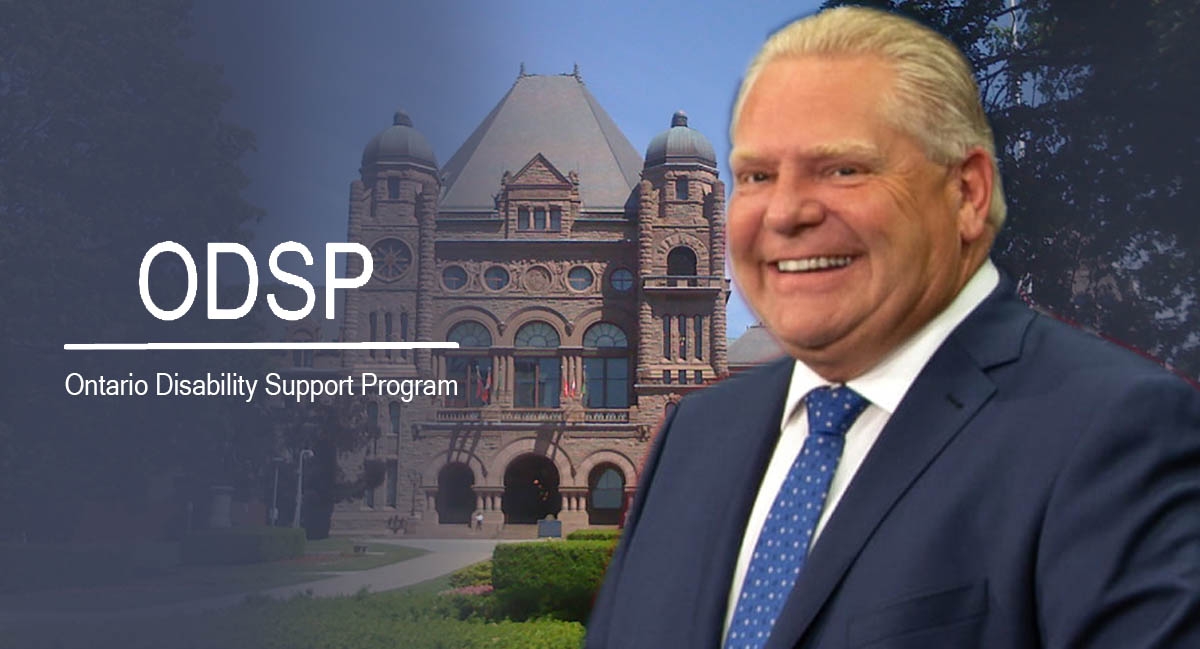
ODSP rates should not be determined according to the whims of the party in power
by Reuel S. Amdur
Since the Ford government announced its budget toward the end of April, the poor and disabled and their advocates have expressed concern about what it will mean for social assistance benefits. There are two programs for social assistance benefits in Ontario, the Ontario Disability Support Program (ODSP), which is provincially administered, and Ontario Works (OW), administered locally. Over the years, the provincially operated program has changed, in the past it also served single parents, but now it serves only the disabled. Eligibility for both programs is based on income and assets. ODSP, of course, also requires establishment of a disability.
Most current attention to benefits is being given to ODSP rates. As an example of this concern, the Ottawa Citizen on April 29 editorialized, “Advocates have long sought overdue help for people on the Ontario Disability Support Program, which pays out a measly $1,169 a month. Nary a whisper in the budget about it.” Randall Denley, whose article appears on the same page, echoes the concern. Recently, CBC’s Ontario Today phone-in show gave over a program to ODSP. So what is missing in this concern? Ontario Works. ACORN (Association of Community Organizations for Action Now), an organization of low and moderate-income people, breaks from the pack by asking for an increase in benefits in both programs, but without specifying by how much.
Single people on Ontario Works get an ordinary maximum of $733. (On both ODSP and OW, there may be amounts for special needs, such as diabetic supplies, for example.) Three questions arise. First, why does this huge difference in rates exist? Then, why the cry of concern for ODSP with much less interest in the predicament of people living on OW? Finally, who is on the two programs?
Back in 1972, the rates for a single person on the provincial and municipal programs were only a couple dollars of difference. The difference occurred because different building blocks were used in setting the rates.
Hamilton Social Planning and Research Council asked René Brunelle, the Tory minister responsible for social assistance at the time, what was the rationale for the rates. In reply, he explained that at one time, rates were based on the Toronto Social Planning Council’s Guide to Family Budgeting but, Brunelle explained, that the rationale had been lost due to changes in rates over the years. This explanation is a major matter of concern. There was no rationale for rates in 1972, and that lack continues to this day. It matters not whether a government was Conservative, Liberal, or New Democratic. But how does that lead us now to a situation where ODSP rates are not that far from double what a person gets on OW?
During the Bill Davis years, the government decided to increase ODSP rates more rapidly. Subsequently, the practice was to raise rates by the same percentage, thus constantly increasing the gap. In one notable exception, Ted McMeekin, when he was Minister of Community and Social Services, provided a bit of an additional bump for singles on OW. He served from 2014 to 2018.
The concern for ODSP over OW is often explained, especially by the province, in claiming that OW is for short-term help and ODSP long-term. However, the ministry’s own figures throw cold water on this argument. The median time on OW is five years. (Median—half above, half below.) We are left with questions of psychology. Label something as being for the disabled, and it tugs at our heartstrings. Simultaneously, there is the oft-cited distinction between the worthy poor, who can’t help it, and the unworthy poor, who are seen as slackers who should just work harder.
If you question whether the matter of worthiness enters into welfare policy, let’s consider another example. For some years, the provincial program included single parents, and it was even called Family Benefits. By far, the greatest number of families were female-led. If the family met such eligibility criteria as income level, it was eligible. There was, however, an interesting distinction. If the woman was a widow, she was immediately eligible. On the other hand, divorced, separated, and single unmarried women had to remain on the municipal program for three months to be eligible. The worthy poor, and the unworthy. Clearly, in the case of the widow, it wasn’t her fault, at least we would hope not.
In addressing our third question, who is on the two programs, intuitively, one would think that the distinction would be rather clear. Not. In line with the distinction between the worthy and unworthy poor, for many years, alcoholism and drug addiction would not count in making one eligible for ODSP. The courts shot that one down. The five-year median on OW raises the question as to why the longer-term OW recipients are not on ODSP.
Reasons vary. Some doctors simply refuse to be bothered with filling out the forms. Some people can’t find a doctor. Some refuse to apply, especially some mentally ill people who refuse to accept the fact. There people are so far out of it that they make it difficult to establish such things as age and place of birth. Then there are cases who apply and are denied. The denial does not make them “normal.” Many denials are ill-founded. In one instance, a psychiatrist’s diagnosis of dementia was not enough to convince the member of the Social Benefits Tribunal that the person was disabled.
While there is an emotional rationale for the different program treatments, reality tells us otherwise. That is why Senator Frances Lankin and Dr. Munir Sheikh recommended, in their 2012 Commission for the Review of Social Assistance in Ontario, that the two programs should be merged.
Still, the question remains. What should the rates be? Should we increase ODSP, and if so, by how much? And how should ODSP rates compare to those on OW?
There is a strong case for the position taken by Lankin and Sheikh that the two programs should be combined, but then what should the rates be? There is the consideration of alternatives such as the basic annual income and reverse income tax or the even more fundamental question of how the nation’s wealth should be distributed. Such alternatives would, in all likelihood, limit if not eliminate the need for public welfare. Here we will limit ourselves to what we should do within the current general structure of social assistance.
It appears that at some point, as Brunelle pointed out, Ontario was on the right track, basing assistance on need. That is how rates should be determined. The current approach is by guess and by golly according to the whims of the party in power and the pressures they feel.
Rates should be informed by Central Mortgage and Housing Corporation (CMHC) housing costs and studies and estimates by nutritionists and home economists. The Market Basket Measure (MBM), a cost-of-living measurement instrument, might be an important element in the determination of need. It establishes the need for goods and services adequate for a modest, basic standard of living. It was developed by Employment and Social Development Canada.
For social assistance, rates should be based on the principle that recipients of assistance are enabled to live in conditions of dignity and decency. The Market Basket Measure may be an instrument that meets that principle.








